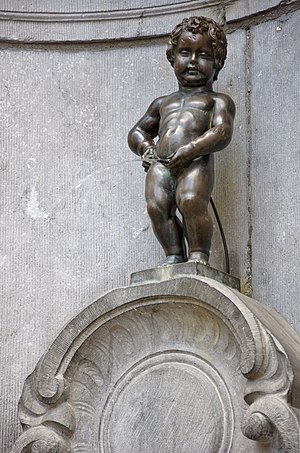Manneken Pis
| Manneken Pis | |
|---|---|
 |
|
| Artist | Jerome Duquesnoy |
| Year | 1388: original version 1619: current version |
| Type | Bronze |
| Dimensions | 61 cm (24 in) |
| Location | Brussels |
| 50°50′42″N 4°21′00″E / 50.84499°N 4.34998°ECoordinates: 50°50′42″N 4°21′00″E / 50.84499°N 4.34998°E | |
Manneken Pis (![]() [ˌmɑnəkə(m) ˈpɪs] , meaning "Little man Pee" in Dutch) is a landmark small bronze sculpture (61 cm) in Brussels, depicting a naked little boy urinating into a fountain's basin. It was designed by Hiëronymus Duquesnoy the Elder and put in place in 1618 or 1619.
[ˌmɑnəkə(m) ˈpɪs] , meaning "Little man Pee" in Dutch) is a landmark small bronze sculpture (61 cm) in Brussels, depicting a naked little boy urinating into a fountain's basin. It was designed by Hiëronymus Duquesnoy the Elder and put in place in 1618 or 1619.
The famous statue is at the junction of Rue de l'Étuve/Stoofstraat and Rue du Chêne/Eikstraat. To find it, one takes the left lane next to the Brussels Town Hall from the famous Grand Place and walks a few hundred metres southwest via Rue Charles Buls/Karel Bulsstraat.
The 61-centimetre (24 in) tall bronze statue on the corner of Rue de l'Etuve and Rue des Grands Carmes was made in 1619 by Brussels sculptor Hieronimus Duquesnoy the Elder, father of the more famous François Duquesnoy. The figure has been repeatedly stolen: the current statue dates from 1965. The original restored version is kept at the Maison du Roi/Broodhuis on the Grand Place.
There are several legends behind this statue, but the most famous is the one about Duke Godfrey III of Leuven. In 1142, the troops of this two-year-old lord were battling against the troops of the Berthouts, the lords of Grimbergen, in Ransbeke (now Neder-Over-Heembeek). The troops put the infant lord in a basket and hung the basket in a tree to encourage them. From there, the boy urinated on the troops of the Berthouts, who eventually lost the battle.
...
Wikipedia
